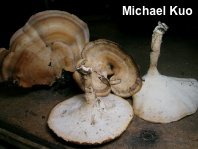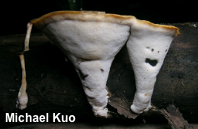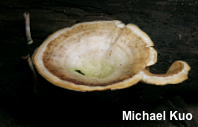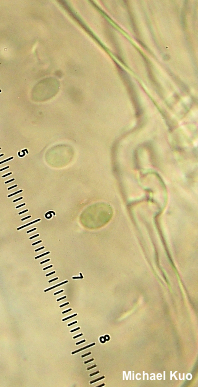| Major Groups > Polypores > Stemmed, Pale-Fleshed > Microporellus obovatus |

|
Microporellus obovatus [ Basidiomycota > Polyporales > Polyporaceae > Microporellus . . . ] by Michael Kuo This pan-tropical polypore appears on the deadwood of hardwoods and features a zoned brownish cap, a fairly well-developed stem, and a whitish pore surface composed of incredibly tiny pores (like, 6–8 of them per millimeter!). Although Microporellus obovatus is primarily distributed in tropical areas, it can be also found in the Midwest and lower northeastern states. Microporellus dealbatus is very similar, but usually grows on the ground rather than from deadwood; it also differs microscopically, since it has dextrinoid skeletal hyphae. Flabellophora obovata and Polyporus mutabilis are among many synonyms. Description: Ecology: Saprobic on decaying hardwood logs and sticks; causing a white rot; growing alone, gregariously, or in small clusters; annual; found in summer and fall in temperate areas and year-round in tropical and subtropical areas; widely distributed in tropical and subtropical North America, and occasional in the lower Midwest and lower eastern states; also present throughout the tropics, in Central America, South America, Africa, Asia, and Australasia. The illustrated and described collection is from Missouri. Cap: 4–8 cm across; circular to fan-shaped, kidney-shaped, or somewhat irregular in outline; usually shallowly to deeply vase-shaped; finely fuzzy; dry; with concentric zones of tan, brown, and whitish. Pore Surface: Running down the stem; whitish to creamy; bruising slowly brownish; pores very minute (6–8 per mm); tubes 1–3 mm deep. Stem: Usually present but occasionally absent; usually off-center; 1–3 cm long; up to 1 cm thick; bald and pale tan below the pore surface; solid. Flesh: Thin; tough; white; unchanging when sliced. Odor and Taste: Not distinctive. Chemical Reactions: KOH negative on all surfaces and flesh. Microscopic Features: Spores 3.5–5 x 2–3 µm; ellipsoid; smooth; hyaline in KOH; inamyloid. Hymenial cystidia not found. Setae not found. Hyphal system dimitic; context monomitic, with generative hyphae 3–6 µm wide, smooth, thin-walled, hyaline in KOH, yellowish and non-dextrinoid in Melzer's, with wide, looping clamp connections; tube trama dimitic, with skeletal hyphae thick-walled, non-dextrinoid. REFERENCES: (Junghung, 1838) Ryvarden, 1972. (Overholts, 1953; David & Rajchenberg, 1985; Gilbertson & Ryvarden, 1987; Nuñez & Ryvarden, 2001; Bessette et al., 2007; Motato-Vásquez & de Mello Gugliotta, 2016; Woehrel & Light, 2017.) Herb. Kuo 09291202. This site contains no information about the edibility or toxicity of mushrooms. |
© MushroomExpert.Com |
|
Cite this page as: Kuo, M. (2020, January). Microporellus obovatus. Retrieved from the MushroomExpert.Com Web site: http://www.mushroomexpert.com/microporellus_obovatus.html |



